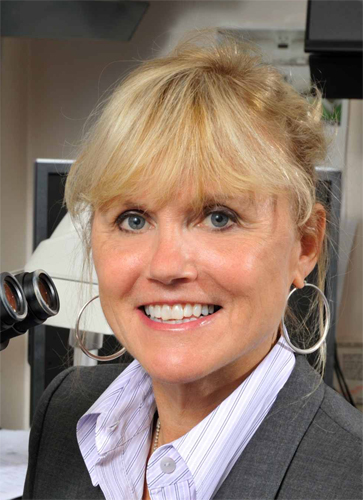Published on September 19, 2013 by Sean Flynt

The free public lecture–Inside the Helmet: Repeated Head Trauma and Degenerative Brain Disease–comes amidst growing concerns about the effects of head trauma in sports at all levels of play, as well as in military combat.
McKee is Professor of Neurology and Pathology at VA Boston HealthCare System and Boston University School of Medicine. She is also Co-Director of the Center for the Study of Traumatic Encephalopathy, Director of the VISN-1 Neuropathology Laboratory for the New England VA Medical Centers and Director of Brain Banks for the Alzheimer Disease Center and Framingham Heart Study.
She is more widely known for her service on the Medical Advisory Board for the Sports Legacy Institute and the Mackey White Traumatic Brain Injury Committee for the National Football League (NFL) Players' Association. She serves as an elected member of the Dana Alliance for Brain Initiatives and the National Academies’ Panel on Human Research and Engineering at the Army Research Laboratory. Her many professional honors include multiple Merit Awards from the Department of Veterans Affairs and the 2012 Impact Award from the Sports Legacy Institute.
Inside the Helmet
The U.S. Centers for Disease Control estimates that U.S. emergency rooms treated more than 200,000 sports-related TBIs every year 2001-2005. Since some athletes either don’t report injuries or aren’t treated in emergency rooms, the actual number of sports-related TBIs is assumed to be higher.
Samford biology professor Betsy Dobbins said these injuries–commonly known as concussions–occur when the brain crashes against the inside of the skull. She said such trauma disrupts the functions of the brain’s neurons, resulting in a host of symptoms, including headache, dizziness, blurred vision, balance problems, light sensitivity, cognitive problems and emotional and sleep disturbances.
These symptoms typically fade in time, but Samford Kinesiology professor Robert Hensarling said there may be long-term or even permanent effects. “If you’ve had a concussion, you’re going to be more susceptible to the next one,” he said, and that one might require less force. Hensarling said the next concussion is also likely to be more severe, with a longer recovery.
Hensarling works with Samford’s athletic trainers to take baseline data on cognition and balance for incoming athletes in some sports, and uses that data to diagnose and help rehabilitate those who sustain concussions. Unfortunately, he said, trainers can’t follow athletes through their careers and later life. “You’re working with a snapshot of an athlete’s life,” he said, while CTE might not present its symptoms until middle age.
Hensarling said the evidence for long term effects of TBI has grown ever more compelling in recent years, with McKee taking a leading role in the research and public awareness. “The group she works with is in the forefront,” he said. “There’s a tremendous amount of interest in this topic”.
Join Howard College of Arts and Sciences on Facebook!
Located in the Homewood suburb of Birmingham, Alabama, Samford is a leading Christian university offering undergraduate programs grounded in the liberal arts with an array of nationally recognized graduate and professional schools. Founded in 1841, Samford enrolls 6,324 students from 44 states, Puerto Rico and 16 countries in its 10 academic schools: arts, arts and sciences, business, divinity, education, health professions, law, nursing, pharmacy and public health. Samford is widely recognized as having one of the most beautiful campuses in America, featuring rolling hills, meticulously maintained grounds and Georgian-Colonial architecture. Samford fields 17 athletic teams that compete in the tradition-rich Southern Conference and boasts one of the highest scores in the nation for its 97% Graduation Success Rate among all NCAA Division I schools.
